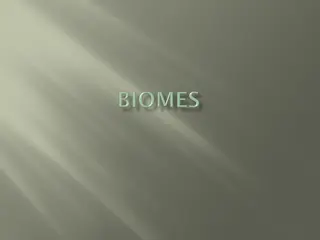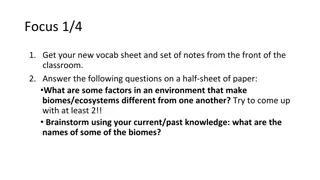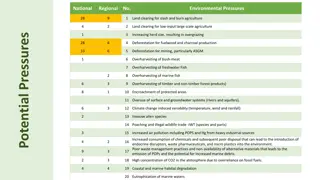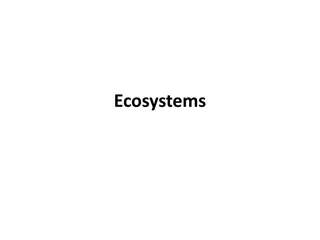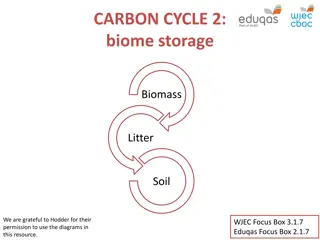Understanding Ecosystems and Global Biomes: A Comprehensive Study
Explore the fascinating world of ecosystems, producers, consumers, and the vital role of decomposers within these intricate systems. Delve into the impact of environmental changes like deforestation on ecosystems. Discover the geographical features and significance of hot deserts, tropical forests, and polar regions in the context of global ecosystems.
Download Presentation

Please find below an Image/Link to download the presentation.
The content on the website is provided AS IS for your information and personal use only. It may not be sold, licensed, or shared on other websites without obtaining consent from the author. Download presentation by click this link. If you encounter any issues during the download, it is possible that the publisher has removed the file from their server.
E N D
Presentation Transcript
Paper 1 Paper 1- - The Living World The Living World GEOG YOUR MEMORY
Ecosystems Ecosystems- - 5.1 + 5.2 5.1 + 5.2 Q1) What is an ecosystem? Q2) What is a producer? Q3) What is a consumer? Q4) What is the role of a decomposer in an ecosystem? Q5) How can change such as deforestation affect an ecosystem?
ANSWERS ANSWERS Q1) What is an ecosystem? A community of plants and animals that interact with each other and their physical environment Q2) What is a producer? An organism or plant that is able to absorb energy from the sun from photosynthesis (makes its own energy) Q3) What is a consumer? A creature that eats animals and/or plants Q4) What is the role of a decomposer in an ecosystem? A decomposer such as bacteria or fungi breaks down dead plant and animal material adding nutrients to the soil (it is part of the nutrient cycle) Q5) How can change such as deforestation affect an ecosystem? Changes in ecosystems can upset the balance of them for example: Deforestation would destroy habitats for animals, it would also affect the nutrient cycle Draining ponds for farming will result in aquatic plants and animals dying Adding fertiliser to water sources such as ponds can lead to eutrophication, this will reduce the amount of oxygen in the water so plant and animal life will die
Global Ecosystems Global Ecosystems- - 5.3 5.3 Q1) What is the geographical term for a large scale ecosystem? Q2) Where are hot deserts located in the world? And give an example of one Q3) Where are tropical forests located in the world? And give an example of one Q4) Why are tropical forests located in this part of the world? Q5) Why do polar regions have low temperatures throughout the year?
ANSWERS ANSWERS Q1) What is the geographical term for a large scale ecosystem? A biome Q2) Where are hot deserts located in the world? And give an example of one Generally hot deserts are found on the tropics/ tropic of cancer (30 N) and tropic of Capricorn (30 S). An example is the Sahara desert in North Africa Q3) Where are tropical forests located in the world? And give an example of one Generally tropical forests are found on/near to the equator (0 ), An example is the Amazon Rainforest in South America. One exception however is the tropical forest found in east Australia Q4) Why are tropical forests located in this part of the world? Tropical forests are found in this area as it is an area of low pressure, meaning it rains a lot, It is also directly on the equator meaning lots of sunlight this allows there to be lots of plant growth Q5) Why do polar regions have low temperatures throughout the year? The reason is because the sun hits the polar regions at a very low angle so they receive a small fraction of the energy that the equator receives, resulting in lower temperatures. The tilt of the earth means that the suns rays are dispersed unevenly meaning the polar regions get the least energy and therefore the lowest temperatures
Global Ecosystems Global Ecosystems- - 6.1 6.1 Q1) What is the climate of a tropical rainforest like? Q2) Define the term biodiversity Q3) What are the 4 layers of the rainforest? (and put them in the correct order of height) Q4) Identify one plant from a tropical rainforest and explain how it has adapted to survive there Q5) Identify one animal from a tropical rainforest and explain how it has adapted to survive there
ANSWERS ANSWERS Q1) What is the climate of a tropical rainforest like? Very high temperatures throughout the year and variable but high rainfall. There are no clear seasons Q2) Define the term biodiversity The variety of life in the world or a particular habitat e.g. in a tropical rainforest Q3) What are the 4 layers of the rainforest? Shrub/ground layer, Lower canopy, Middle canopy, Top canopy/emergent layer Q4) Identify one plant from a tropical rainforest and explain how it has adapted to survive there Drip tip leaf- this has a conical shape and drip tip at the end of the leaf to allow excess water to be removed, this prevents the leaf from growing mould/bacteria Buttress roots- Large exposed roots used to support the tallest emergent trees, they are able to absorb nutrients to support plant growth Lianas/strangler figs- these are woody creepers which wrap themselves around other trees to support them, they are epiphytes absorb nutrients from other plants to help them grow *add in any other specific ones you may have taught
ANSWERS ANSWERS Q5) Identify one animal from a tropical rainforest and explain how it has adapted to survive there Howler Monkey- has a tail to help it move/swing through the trees, it also has hands to allow it to grip onto branches Sloth- moves very slowly to conserve energy, overtime the sloth turns green as it doesn t wash, this allows it to camouflage, long claws to grip onto the trees when climbing *add in any other specific ones you may have taught
Global Ecosystems Global Ecosystems- - 6.1 Q1) Using figure 1 calculate the temperature range for a tropical forest 6.1 Q2) Using figure 1, what is the total annual rainfall in a tropical forest Q3) Using figure 1, what is the maximum temperature in a tropical rainforest? Q4) Using figure 1, what is the minimum amount of rainfall in a tropical forest Q5) Using figure 1 describe what the climate of a tropical forest is like Figure 1
ANSWERS ANSWERS Q1) Using figure 1 calculate the temperature range for a tropical forest = 2 (Highest (29) LOWEST (27) Q2) Using figure 1, what is the total annual rainfall in a tropical forest =2161mm (add all the rainfall values together) Q3) Using figure 1, what is the maximum temperature in a tropical rainforest? =29 C Q4) Using figure 1, what is the minimum amount of rainfall in a tropical forest = 65 mm Q5) Using figure 1 describe what the climate of a tropical forest is like Hot and humid, high but variable rainfall. There are no distinct seasons in tropical forests Figure 1
Causes of deforestation 6.2 Causes of deforestation 6.2 Q1) What is deforestation? Q2) What is your case-study for tropical forests? Q3) Using figure 8, which region of the world had the greatest rate of deforestation? Q4)Why do some countries deforest more than others? Q5) Explain one cause of deforestation
ANSWERS ANSWERS Q1) What is deforestation? The chopping down and removal of trees to clear an area of forest Q2) What is your case-study for tropical forests? Malaysia Q3) Using figure 8, which region of the world had the greatest rate of deforestation? Central America Q4)Why do some countries deforest more than others? They have more tropical forests, their main income (primary industry in LICS/NEEs), land needed Q5) Explain one cause of deforestation Logging, Road building, Mineral extraction/mining, energy/HEP, commercial farming/subsistence farming
Impacts of deforestation 6.3 Impacts of deforestation 6.3 Q1) What is selective logging? Q2) What is commercial farming? Q3) Outline one impact of deforestation? Q4) How does deforestation create economic advantages but at a cost to the environment?
ANSWERS ANSWERS Q1) What is selective logging? The cutting down of trees which are mature or inferior to encourage the growth of the remaining trees in the forest Q2) What is commercial farming? Farming to sell produce for a profit to retailers or food processing companies Q3) Outline one impact of deforestation? Climate change- Tropical forests are carbon stores, if trees are chopped down carbon is released into the atmosphere, as it is a greenhouse gas it increases global warming Loss of biodiversity- As trees are chopped down, animals habitats are lost, this may result in extinctions Soil erosion- Tree roots hold soil together, if the trees are removed the soil is loose and exposed, the rain washes the soil and nutrients away- this is called leaching Q4) How does deforestation create economic advantages but at a cost to the environment? Economic advantages- it generates an income from logging/mining and selling the products, through employment Cost to the environment- Soil erosion, water pollution, forest fires, plant and animal extinctions
Managing tropical forests 6.4 Managing tropical forests 6.4 Q1) Why do we need to protect tropical forests? Q2) What is selective logging? Q3) What is sustainability? Q4) What is debt reduction? Q5) Outline one way we can manage tropical forests sustainably
ANSWERS ANSWERS- - Q1) Why do we need to protect tropical forests? Biodiversity- Tropical forests contain more than 50% of the worlds plant and animal species Medicine- 25% of medicines are from tropical forests, also new possible cures yet to be discovered Climate change- Tropical forests store carbon dioxide (carbon store) so less in the atmosphere Indigenous Tribes- people who are living in the forests Q2) What is selective logging? The cutting down of trees which are mature or inferior to encourage the growth of the remaining trees in the forest Q3) What is sustainability? Actions and progress that meets the needs of the present without reducing the ability of future generation to meet their needs Q4) What is debt reduction? Countries are relieved of their debt in return for protecting their tropical forests
ANSWERS ANSWERS- - Q5) Outline one way we can manage tropical forests sustainably Selective logging and replanting- selecting the trees 1-2 years prior to be chopped down, then chopping them down, then replanting afterwards Conservation and education- encourages the preservation of forest through nature reserves and research. Ecotourism- holidays which introduce people to the natural world and how to protect it, people would stay in eco-lodges etc.. International agreements- e.g. debt reduction- agreeing to reduce a countries debt and in return they reduce their rate of deforestation.
Cold environments 8.1 Cold environments 8.1 Q1) Where are polar environments located in the world? Generally polar environments are located in the very north of the northern hemisphere and south of the southern hemisphere. For example Antarctica Q2) Where are tundra environments located in the world? Tundra environments are slightly below polar environments on the line of latitude, they are found in the northern part of the northern hemisphere. For example North Canada. Q3) What is permafrost? Permanently frozen ground found in polar and tundra regions Q4) Identify one difference between a polar and tundra environment Temperature- tundra is slightly warmer than polar as it a few degrees lower in latitude Soil- Permafrost in polar, in tundra the permafrost melts during the summer/warmer months Plants- few plants in the polar region, more found in tundra such as the bearberry Animals- well adapted animals in polar e.g the polar bear, more variety in tundra e.g. the arctic fox, birds, insects
Geog Geog your memory your memory Q1) How have plants (such as the bearberry) adapted to living in a cold environment? Grows low to the ground, so it is protected from strong winds Hairy stems insulate the plant from cold temperatures/snow Bright red berries attract birds and help spread the seeds Q2) Outline one way we can manage tropical forests sustainably Selective logging and replanting- selecting the trees 1-2 years prior to be chopped down, then chopping them down, then replanting afterwards Conservation and education- encourages the preservation of forest through nature reserves and research. Ecotourism- holidays which introduce people to the natural world and how to protect it, people would stay in eco-lodges etc.. International agreements- e.g. debt reduction- agreeing to reduce a countries debt and in return they reduce their rate of deforestation.
Opportunities and challenges in cold environments 8.2 Opportunities and challenges in cold environments 8.2- -8.3 8.3 Q1) What is your cold environment case-study? Q2) Where is this located in the world? Q3) How many people are employed in coal mining here? Q4) How many species are fish are found in the Barent Sea? Q5) Outline one opportunity for development in this cold environment
Opportunities and challenges in cold environments 8.2 Opportunities and challenges in cold environments 8.2- -8.3 8.3 Q1) What is your cold environment case-study? Svalbard Q2) Where is this located in the world? Svalbard is an island in the most northerly part of the world, (80 N), it is the territory of Norway, located in the north Atlantic Ocean Q3) How many people are employed in coal mining here? 300 people Q4) How many species are fish are found in the Barent Sea? 150 species
Opportunities and challenges in cold environments 8.2 Opportunities and challenges in cold environments 8.2- -8.3 8.3 Q5) Outline one opportunity for development in this cold environment Coal Mining/Mineral extraction- employs 300 people, provides and income through trade, however it is controversial environmentally Geothermal energy/energy developments- Svalbard utilises its natural geothermal energy for power stations which serve all of Svalbard- this is a likely source of energy for the future Fishing- Barent sea is rich with 150 species of fish, this can be traded and sold to bring in an income, however it is monitored to prevent overfishing Tourism- provides 300 jobs (as many as mining), popular attractions include the northern lights, glaciers and the wildlife, 70,000 tourists visited Longyearbyen in 2011
Opportunities and challenges in cold environments 8.2 Opportunities and challenges in cold environments 8.2- -8.3 8.3 Q1) What is meant by the term infrastructure? Q2) Why is construction (building things) so difficult in Svalbard? Q3) Outline one challenge to development in cold environments?
ANSWERS ANSWERS Q1) What is meant by the term infrastructure? Thiings that help humans to live somewhere, water, electricity, roads and paths, hospitals , schools. Q2) Why is construction (building things) so difficult in Svalbard? Extreme temperatures of -30 C makes manual labour difficult/risk of frostbite Most construction work has to be done in the summer due to the temperature and hours of sunlight Permafrost/frozen ground makes laying pipes more difficult Q3) Outline one challenge to development in cold environments? Extreme temperatures- winter temperatures can fall below -30 C, this brings a risk of frostbite and hyperthermia, lots of layers of clothing have to be worn- this can slow down work and make it more difficult. Construction- most construction work takes place in the summer due to the temperatures and day light hours, the permafrost has to be protected from melting and damaging the ground underneath Services- Pipes for water, power, sewage/sanitation have to be raised above the ground to prevent them from damaging the permafrost layer Accessibility- Svalbard is not very accessible, it has one port, one air port and only 50km of road in Longyearbyen, most people travel by snow mobile
Cold environments under threat and management 8.4 Cold environments under threat and management 8.4- -8 8- -5 5 Q1) What is meant by a fragile environment Q2) How are cold environments being damaged? Q3) What is meant by a wilderness area? Q4) How can technology help protect cold environments? Q5) How can governments help protect cold environments?
ANSWERS ANSWERS- - Q1) What is meant by a fragile environment An environment which is both easily disturbed and hard to restore if damaged Q2) How are cold environments being damaged? Drilling for oil can result in oil spills which damage the environment and the things living in it, off roading by tourists damages the permafrost and the ground underneath Q3) What is meant by a wilderness area? A natural area which has not been significantly modified by human activity. These are the most intact, undisturbed places left on earth Q4) How can technology help protect cold environments? Pipelines (like the trans-Alaskan pipeline) raised above the ground transport oil across countries, they are raised to reduce the damage to the permafrost and allow the caribou to migrate, automatic shut off systems if there is a leak to prevent oil spills damaging the environment Q5) How can governments help protect cold environments? Laws and policies can be made to protect wilderness areas, for example the Antarctic treaty. This was put in place to prevent any economic development, promote scientific research.





